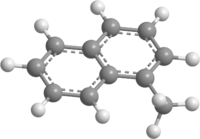1-methylnaphthalene
 |
|
 |
|
| Names | |
|---|---|
|
IUPAC name
1-Methylnaphthalene
|
|
| Other names
α-methylnaphthalene
|
|
| Identifiers | |
|
3D model (Jmol)
|
|
| ChEBI | |
| ChemSpider | |
| ECHA InfoCard | 100.001.788 |
| EC Number | 201-966-8 |
| KEGG | |
|
PubChem CID
|
|
|
|
|
|
| Properties | |
| C11H10 | |
| Molar mass | 142.20 g/mol |
| Appearance | Liquid |
| Density | 1.001 g/mL |
| Melting point | −22 °C (−8 °F; 251 K) |
| Boiling point | 240–243 °C (464–469 °F; 513–516 K) |
| Vapor pressure | 4.91 |
| -102.8·10−6 cm3/mol | |
| Hazards | |
| R-phrases (outdated) | R22 R42 R43 |
| S-phrases (outdated) | S7 S36 S37 S39 |
| Flash point | 82 °C (180 °F; 355 K) |
|
Except where otherwise noted, data are given for materials in their standard state (at 25 °C [77 °F], 100 kPa).
|
|
|
|
|
| Infobox references | |
1-Methylnaphthalene is a polycyclic aromatic hydrocarbon (PAH). It has a cetane number of zero, and was previously used as the lower reference for cetane number. However, due to the expense and handling difficulty of 1-methylnaphthalene, it was replaced in this capacity by isocetane, with a CN of 15.
On February 22, 2014, NASA announced a greatly upgraded database for detecting and monitoring PAHs, including 1-methylnaphthalene, in the universe. According to NASA scientists, over 20% of the carbon in the universe may be associated with PAHs, possible starting materials for the formation of life. PAHs seem to have been formed shortly after the Big Bang, are abundant in the universe, and are associated with new stars and exoplanets.
...
Wikipedia
